University of Surrey (UNIS)
Latest uploads at University of Surrey (UNIS). Looking for notes at University of Surrey (UNIS)? We have lots of notes, study guides and study notes available for your school.
-
215
-
3
-
13
Majors at University of Surrey (UNIS)
Notes available for the following studies at University of Surrey (UNIS)
-
Biomedical Sciences 7
-
Tourism and Management 1
-
University of Surrey 50
Popular books University of Surrey (UNIS)

Institution Of Civil Engineers • ISBN 9780727764409
Latest notes & summaries University of Surrey (UNIS)
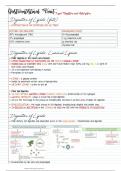
Provides a good base knowledge of how fats are digested throughout the GI system and how they are then absorbed. Introduces the different types of fat composition that are present within the GI tract, as well as introduces the role of key enzymes, e.g. lipase. and their role in digestion. Then starts to explain the 4 different stages that are vital part of digestion and breaks them down further with a more in-depth review with images to help understand better.
- Class notes
- • 4 pages's •
-
University of Surrey•Integration Of Physiological Systems
Preview 1 out of 4 pages
Provides a good base knowledge of how fats are digested throughout the GI system and how they are then absorbed. Introduces the different types of fat composition that are present within the GI tract, as well as introduces the role of key enzymes, e.g. lipase. and their role in digestion. Then starts to explain the 4 different stages that are vital part of digestion and breaks them down further with a more in-depth review with images to help understand better.
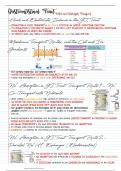
Provides a good introduction to the different types of ways that electrolytes and water can be balanced as part of the GI system. It introduces the membrane routes that are taken both at a cellular level and ion. Then goes on to explain the different chemical transports taken and their routes e.g. sodium co-transport with nutrients. Most information is on the sodium transport, but there is also a good amount of information on the potassium and chloride transport, and there are pictures within ea...
- Class notes
- • 3 pages's •
-
University of Surrey•Integration Of Physiological Systems
Preview 1 out of 3 pages
Provides a good introduction to the different types of ways that electrolytes and water can be balanced as part of the GI system. It introduces the membrane routes that are taken both at a cellular level and ion. Then goes on to explain the different chemical transports taken and their routes e.g. sodium co-transport with nutrients. Most information is on the sodium transport, but there is also a good amount of information on the potassium and chloride transport, and there are pictures within ea...

in-depth analysis of the threats and opportunities of netflix
- Other
- • 6 pages's •
-
University of Surrey•International Business Strategy
Preview 2 out of 6 pages
in-depth analysis of the threats and opportunities of netflix
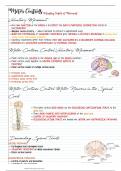
Introduces what voluntary movement is, before going into the areas of the brain that control these voluntary movements. It explains how each area has a vital role to play and the pathway/tracts that they use to elicit a voluntary response. There is also information about a study that was conducted on the part of the cortical motor neurones in monkeys, and the key findings that were found through the experiment. The end of the lecture follows the networks that are involved in creating the volunta...
- Class notes
- • 5 pages's •
-
University of Surrey•Integration Of Physiological Systems
Preview 2 out of 5 pages
Introduces what voluntary movement is, before going into the areas of the brain that control these voluntary movements. It explains how each area has a vital role to play and the pathway/tracts that they use to elicit a voluntary response. There is also information about a study that was conducted on the part of the cortical motor neurones in monkeys, and the key findings that were found through the experiment. The end of the lecture follows the networks that are involved in creating the volunta...

An introduction to parts of the brain that are in control of the process of movement. It gives a brief overview of the parts of the brain involved, before going into more detail about the function and explanation of the receptors, tissues, etc. involved in that area of the brain. It also includes information about the different types of pathways that areas of the brain used for signalling, as well as discussing some diseases that can have an affect on the pathway of the brain, which then impact ...
- Class notes
- • 3 pages's •
-
University of Surrey•Integration Of Physiological Systems
Preview 1 out of 3 pages
An introduction to parts of the brain that are in control of the process of movement. It gives a brief overview of the parts of the brain involved, before going into more detail about the function and explanation of the receptors, tissues, etc. involved in that area of the brain. It also includes information about the different types of pathways that areas of the brain used for signalling, as well as discussing some diseases that can have an affect on the pathway of the brain, which then impact ...
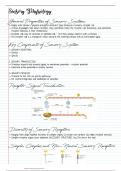
Gives an in-depth look into sensory physiology. This introduces you to the general properties of the sensory system to ease you into the lecture before going into the key properties and pathways. You are then introduced to the 4 different types of receptors that make-up the sensory pathway, first with a general overview and then each goes into more detail and explanation further down. There are examples throughout, such as the receptors that are found in the skin and their mechanism of action, a...
- Class notes
- • 6 pages's •
-
University of Surrey•Integration Of Physiological Systems
Preview 2 out of 6 pages
Gives an in-depth look into sensory physiology. This introduces you to the general properties of the sensory system to ease you into the lecture before going into the key properties and pathways. You are then introduced to the 4 different types of receptors that make-up the sensory pathway, first with a general overview and then each goes into more detail and explanation further down. There are examples throughout, such as the receptors that are found in the skin and their mechanism of action, a...
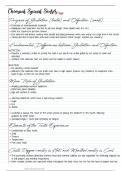
A nice overview of taste and smell, by giving definitions of each and showing the difference in chemical signalling between each sense. It explains the role of gustation and goes into detail about the ligands and receptors involved in the process of taste. It also explains physiological parts of the anatomy and the cells that are found within that anatomy. It then finishes off by talking about the mechanisms that are involved in the different cell-types found in the taste sense.
- Class notes
- • 4 pages's •
-
University of Surrey•Integration Of Physiological Systems
Preview 1 out of 4 pages
A nice overview of taste and smell, by giving definitions of each and showing the difference in chemical signalling between each sense. It explains the role of gustation and goes into detail about the ligands and receptors involved in the process of taste. It also explains physiological parts of the anatomy and the cells that are found within that anatomy. It then finishes off by talking about the mechanisms that are involved in the different cell-types found in the taste sense.

A brief introduction into the chemical process involved in the smelling process. Gives a nice introduction to the types of tissue and receptors involved. At the end of the notes, there is a a bit of background into covid-19 and how one of the main symptoms (loss of smell) came out and the biological and biochemical reasoning.
- Class notes
- • 2 pages's •
-
University of Surrey•Integration Of Physiological Systems
Preview 1 out of 2 pages
A brief introduction into the chemical process involved in the smelling process. Gives a nice introduction to the types of tissue and receptors involved. At the end of the notes, there is a a bit of background into covid-19 and how one of the main symptoms (loss of smell) came out and the biological and biochemical reasoning.

Contains a basic overview of how the ear picks up on sound, pitch, amplitude and frequency. Gives definitions of each part and relates back to human physiology
- Class notes
- • 1 pages's •
-
University of Surrey•Integration Of Physiological Systems
Preview 1 out of 1 pages
Contains a basic overview of how the ear picks up on sound, pitch, amplitude and frequency. Gives definitions of each part and relates back to human physiology

Contains the anatomy of the ear such as the ear drum, pinna and the cochlea. Goes on to give a more detailed account of each section that makes up the hearing apparatus and its overall function.
- Class notes
- • 2 pages's •
-
University of Surrey•Integration Of Physiological Systems
Preview 1 out of 2 pages
Contains the anatomy of the ear such as the ear drum, pinna and the cochlea. Goes on to give a more detailed account of each section that makes up the hearing apparatus and its overall function.
